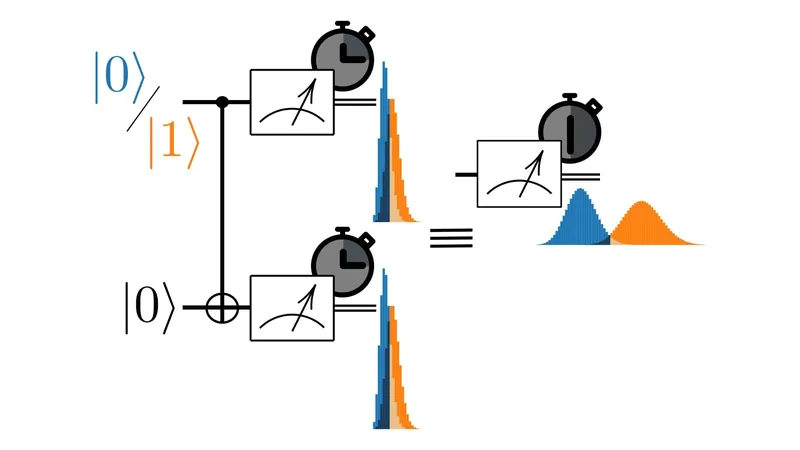
Revolutionary Breakthrough: Scientists Harness Space-Time Trade-Off to Accelerate Quantum Measurements
2025-03-29
Author: Wei Ling
In an exciting development that could reshape the landscape of quantum computing, researchers have unveiled a groundbreaking method to enhance the speed of quantum measurements. Published in *Physical Review Letters*, the study introduces a space-time trade-off scheme aimed at overcoming some of the significant challenges faced by quantum computing today.
Quantum computing is no walk in the park. Key hurdles include high error rates, maintaining qubit stability, and scaling up systems beyond a small number of qubits. However, one of the most critical and often overlooked obstacles is the fidelity and speed of quantum measurements themselves. Rapid and accurate measurements are essential for advancing quantum technologies, particularly as they relate to quantum error correction processes.
The team behind this innovative research, led by Christopher Corlett, alongside Professor Noah Linden and Dr. Paul Skrzypczyk from the University of Bristol, collaborated with experts from institutions such as the University of Oxford, University of Strathclyde, and Sorbonne Université. Together, they tackled the measurement speed issue by using additional or ancillary qubits, effectively decreasing the time required for measurements while either maintaining or enhancing their quality.
According to Corlett, "The measurement process in quantum mechanics is one of its most important and fascinating features. It is also vital for future quantum technologies." Dr. Skrzypczyk added, “Fast and accurate quantum measurements are crucial for advancing emerging quantum technologies. Our study highlights the urgent need for speed in order to support error correction, without which fault tolerance would remain a distant dream.”
The researchers employed an ingenious analogy to illustrate the measurement challenge: consider trying to determine which of two glasses contains more water by eyesight. A single glance may not provide enough information, but extended observation can enhance accuracy. The study proposes that by introducing ancillary qubits, researchers can effectively amplify the measurement information gathered within a set timeframe. This is akin to increasing the perceived volume of water in each glass, allowing for a more straightforward comparison.
Under the system outlined in the study, instead of continuing to measure the target qubit over an extended period, measurements are conducted simultaneously on both the target qubit and its ancillary counterparts. This means that effectively, multiple qubits can be measured for a reduced time. For instance, measuring five qubits for one second could yield the same statistical confidence level as measuring a single qubit for five seconds.
What’s particularly impressive is the scalability of this method. Professor Corlett noted, “If we keep adding auxiliary qubits, we can significantly enhance the readout speed, allowing us to discern differences more rapidly and accurately.”
Furthermore, the researchers validated their method under ideal conditions without noise, confirming a linear speed increase correlating with the number of qubits used. Even in scenarios incorporating realistic noise models, the approach demonstrated significant improvement, often surpassing expectations of linear enhancement. Their scheme shows remarkable resilience against noise, ensuring it remains applicable in real-world scenarios where disturbances are inevitable.
The excitement around this discovery is palpable. The researchers are keen to translate their theoretical findings into experimental applications, particularly targeting superconducting qubit systems as the next step. This groundbreaking research may pave the way for more efficient quantum computing systems in the near future, consistently overcoming hurdles that have long impeded progress in the field.
As scientists work diligently to realize the full potential of this innovative framework, the future of quantum measurement technology seems brighter than ever. Will this breakthrough be the key to unlocking true quantum revolution? Only time will tell, but the possibilities are undeniably thrilling.



 Brasil (PT)
Brasil (PT)
 Canada (EN)
Canada (EN)
 Chile (ES)
Chile (ES)
 Česko (CS)
Česko (CS)
 대한민국 (KO)
대한민국 (KO)
 España (ES)
España (ES)
 France (FR)
France (FR)
 Hong Kong (EN)
Hong Kong (EN)
 Italia (IT)
Italia (IT)
 日本 (JA)
日本 (JA)
 Magyarország (HU)
Magyarország (HU)
 Norge (NO)
Norge (NO)
 Polska (PL)
Polska (PL)
 Schweiz (DE)
Schweiz (DE)
 Singapore (EN)
Singapore (EN)
 Sverige (SV)
Sverige (SV)
 Suomi (FI)
Suomi (FI)
 Türkiye (TR)
Türkiye (TR)
 الإمارات العربية المتحدة (AR)
الإمارات العربية المتحدة (AR)